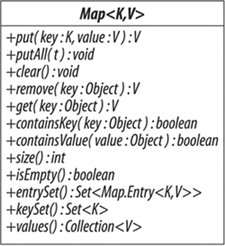Chapter 16. Maps
| The Map interface is the last of the major Collections Framework interfaces, and the only one that does not inherit from Collection. It defines the operations that are supported by a set of key-to-value associations in which the keys are unique. These operations are shown in Figure 16.1 and fall into the following four groups, broadly parallel to the four operation groups of Collectionadding elements, removing elements, querying collection contents, and providing different views of the contents of a collection. Figure 16-1. Map Adding Associations V put(K key, V value) // add or replace a key-value association // return the old value (may be null) if the // key was present; otherwise returns null void putAll(Map<? extends K,? extends V> m) // add each of the key-value associations in // the supplied map into the receiver The operations in this group are optional; calling them on an unmodifiable map will result in an UnsupportedOperationException. Removing Associations void clear() // remove all associations from this map V remove(Object key) // remove the association, if any, with the // given key; returns the value with which it // was associated, or null The signature of Map.remove is like that of the Collection.remove (see Section 12.1) in that it takes a parameter of type Object rather than the generic type. We discussed alternatives to this design in Section 2.6. Like the addition operations of the previous group, these removal operations are optional. Querying the Contents of a Map V get(Object k) // return the value corresponding to k, or // null if k is not present as a key boolean containsKey(Object k) // return true if k is present as a key boolean containsValue(Object v) // return true if v is present as a value int size() // return the number of associations boolean isEmpty() // return true if there are no associations The arguments to containsKey and containsValue may be null for Map implementations that allow null keys or values (respectively). An implementation that does not allow nulls will throw NullPointerException if supplied with a null argument to these methods. As with the size method of Collection, the largest element count that can be reported is Integer.MAX_VALUE. Providing Collection Views of the Keys, Values, or Associations: Set<Map.Entry<K, V>> entrySet() // return a Set view of the associations Set<K> keySet() // return a Set view of the keys Collection<V> values() // return a Collection view of the values The collections returned by these methods are backed by the map, so any changes to them are reflected in the map itself, and vice versa. In fact, only limited changes can be made via the view: elements can be removed, either directly or via an iterator over the view, but cannot be added; you will get an UnsupportedOperationException if you try. Removing a key removes the single corresponding key-value association; removing a value, on the other hand, removes only one of the associations mapping to it; the value may still be present as part of an association with a different key. An iterator over the view will become undefined if the backing map is concurrently modified. The members of the set returned by enTRySet implement the interface Map.Entry, which represents a key-value association and provides a setValue method which can be used to change values in the backing map. The documentation for Map.Entry is unusually specific in specifying that objects implementing the interface can only be created during iteration of the view resulting from a call of entrySet, and that such objects become invalid if the backing map is modified during this iteration. In Java 6 this restricted scenario for the creation of Map.Entry objects is insufficient, as it is the return type for a number of methods of NavigableMap (see Section 16.3). |
EAN: 2147483647
Pages: 136